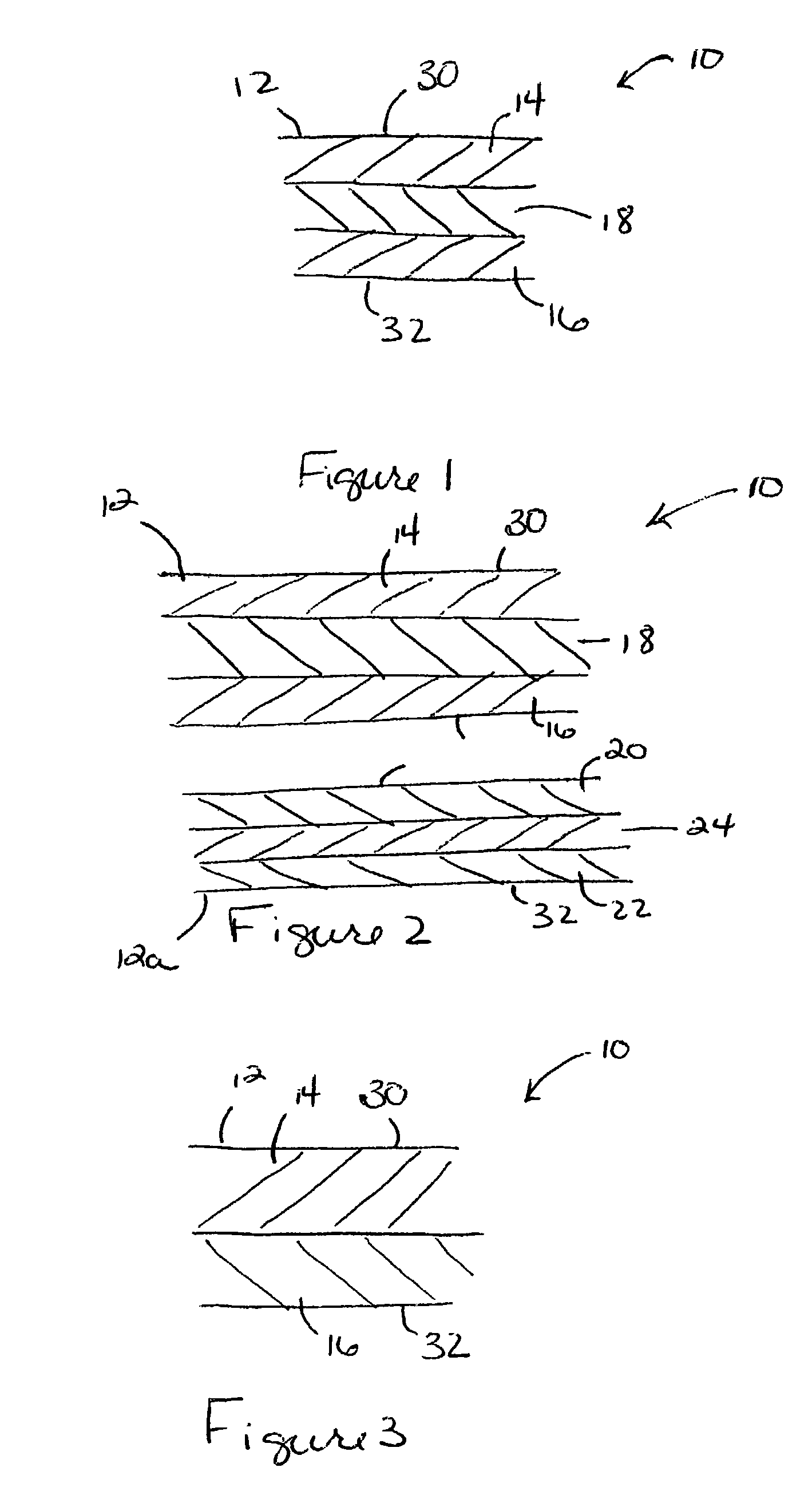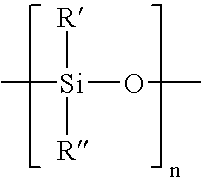Soft tissue hydrophilic tissue products containing polysiloxane and having unique absorbent properties
- Summary
- Abstract
- Description
- Claims
- Application Information
AI Technical Summary
Benefits of technology
Problems solved by technology
Method used
Image
Examples
example 1
[0141]The tissue sheet was manufactured according to the following procedure. About 60 pounds of polysiloxane pretreated eucalyptus hardwood kraft pulp fibers, comprising about 1.5% polysiloxane, were dispersed in a pulper for 30 minutes, forming an eucalyptus hardwood kraft pulp fiber slurry having a consistency of about 3%. The Eucalyptus hardwood pulp fiber slurry was then transferred to a machine chest and diluted to a consistency of about 0.75%.
[0142]About 60 pounds, air dry basis weight, of LL-19 northern softwood kraft pulp fibers were dispersed in a pulper for 30 minutes, forming a northern softwood kraft pulp fiber slurry having a consistency of about 3%. A low level of refining was applied for 6 minutes to the northern softwood kraft pulp fibers. After dispersing, the northern softwood kraft pulp fibers to form the slurry, the northern softwood kraft pulp fibers were passed to a machine chest and diluted to a consistency of about 0.75%. 1.8 pounds per ton of a commercially...
example 2
[0146]The tissue sheet was manufactured according to the following procedure. About 30 pounds of polysiloxane pretreated eucalyptus hardwood kraft pulp fibers, comprising about 1.5% polysiloxane, and about 30 pounds of non-treated eucalyptus hardwood kraft pulp fibers (pulp fibers not pretreated with polysiloxane) were dispersed in a pulper for about 30 minutes, forming an eucalyptus hardwood kraft pulp fiber slurry comprising eucalyptus hardwood kraft polysiloxane pretreated pulp fibers and eucalyptus hardwood kraft non-treated pulp fibers having a consistency of about 3%. The Eucalyptus hardwood kraft pulp fiber slurry was then transferred to a machine chest and diluted to a consistency of about 0.75%.
[0147]About 60 pounds, air dry basis weight, of LL-19 northern softwood kraft pulp fibers were dispersed in a pulper for about 30 minutes, forming a northern softwood kraft pulp fiber slurry having a consistency of about 3%. A low level of refining was applied for about 6 minutes to ...
example 3
[0151]The tissue sheet was manufactured according to the following procedure. About 15 pounds of polysiloxane pretreated eucalyptus hardwood kraft pulp fibers, comprising about 1.5% polysiloxane, and about 45 pounds of non-treated eucalyptus hardwood kraft pulp fibers (pulp fibers not pretreated with polysiloxane) were dispersed in a pulper for about 30 minutes, forming an eucalyptus hardwood pulp kraft fiber slurry comprising eucalyptus hardwood kraft polysiloxane pretreated pulp fibers and eucalyptus hardwood kraft non-treated pulp fibers having a consistency of about 3%. The Eucalyptus hardwood fiber slurry was then transferred to a machine chest and diluted to a consistency of about 0.75%.
[0152]About 60 pounds, air dry basis weight, of LL-19 northern softwood kraft pulp fibers were dispersed in a pulper for about 30 minutes, forming a northern softwood kraft pulp fiber slurry having a consistency of about 3%. A low level of refining was applied for about 6 minutes to the norther...
PUM
| Property | Measurement | Unit |
|---|---|---|
| Fraction | aaaaa | aaaaa |
| Fraction | aaaaa | aaaaa |
| Fraction | aaaaa | aaaaa |
Abstract
Description
Claims
Application Information
 Login to View More
Login to View More - R&D
- Intellectual Property
- Life Sciences
- Materials
- Tech Scout
- Unparalleled Data Quality
- Higher Quality Content
- 60% Fewer Hallucinations
Browse by: Latest US Patents, China's latest patents, Technical Efficacy Thesaurus, Application Domain, Technology Topic, Popular Technical Reports.
© 2025 PatSnap. All rights reserved.Legal|Privacy policy|Modern Slavery Act Transparency Statement|Sitemap|About US| Contact US: help@patsnap.com



